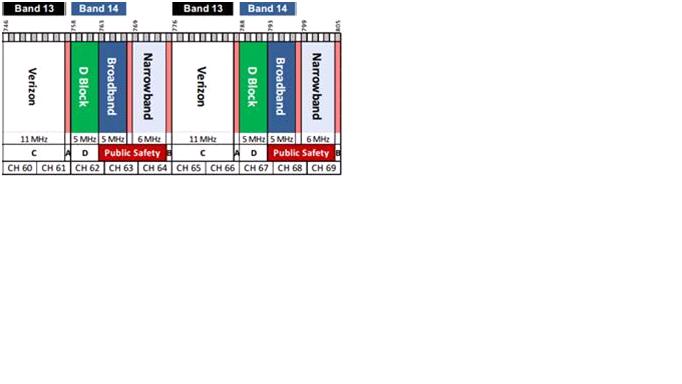In 2012, Congress allocated $7 billion for the construction of a mobile network which will serve 2.5 million police, fire, and emergency workers and approximately 60,000 local agencies. It is the First Responder Network Authority, or FirstNet.
FirstNet is a quasi-governmental entity, established to operate as an independent authority within the NTIA (National Telecommunications Information Administration), an agency in the Department of Commerce. FirstNet has been tasked with the huge task responsible for constructing and operating an interoperable, nationwide LTE mobile network for the country’s public safety workers. FirstNet is starting from scratch -since the company is brand new and thus has no past experience as an entity for building any networks. Think of it as a government start-up building the equivalent network to AT&T or T-Mobile in 10 years. Congress eliminated the need to purchase spectrum by dedicating 700Mhz "beachfront" spectrum for FirstNet. These are “TV Channels" 62-64 and 67-69 (763-768/793-798 MHz broadband, 769-775/799-805 MHz narrowband, 768-769/798-799 MHz guard bands).

Dick Tracy: Future Public Safety Communications. The FirstNet LTE mobile network must serve public safety, meaning fire and police but also covering EMTs and all possible first responders in all 36,000 municipalities in the country. FirstNet will eventually replace the currently reliable, and always working, 2-way 470MHz voice radio systems. Unlike the 2-way radios, FirstNet will deliver video, data, and voice to ruggedized smartphones and other smart devices like watches, glasses, and wearable’s. However, our typical mobile phone statements like “I’m about to lose cell coverage” to police dispatch will not suffice in the new network.
Fragile v. Anti-fragile. FirstNet has gotten off to a slow start. It could be blamed on lack of first year funding approvals or on micro/local v. macro/national focus. As we all know intuitively, local public safety agencies are much more likely to build an “anti-fragile” "never go down" radio network (a word coined by one of my favorite economists, Nassim Nicholas Taleb, who noted: “The way people handle local affairs is vastly different from the way they handle large, abstract public expenditures: we have traditionally lived in small units and tribes and managed rather well in small units.”) If a town’s 2-way public safety radio system fails, the local public safety officers will suffer the immediate consequences. Therefore, the local agency will work diligently remove all failure points. A national system, built with serving vast geographical areas, using a highly centralized LTE eNodeB and EPC network – with identifiable failure points – will more easily be able to ignore small, statistically "insignificant" network failures in a small town, in favor of the “national good.” Local agencies are well aware of the issue because it is the local public safety first responders and the local residents they are serving that matters when using the new mobile network, not the national network as a whole. If FirstNet is not effective and very reliable locally, then it will not be effective and reliable to those who are using it.
New FirstNet RFIs. On July 10, 2013, FirstNet issued 10 RFIs. They include questions on: 1) data centers, 2) backhaul transmission, 3) network service platforms like IMS, 4) network operation center (NOC) management systems, 5) EPC (enhanced packet core) functionality – how LTE handles centralization of network traffic like roaming and priority, 6) satellite services for remote areas, 7) portable cell “towers”, 8) point-to-point radios like White Spaces radios for back haul, 9) specialty antennas for rural areas, and 10) RAN (radio access network) operations, partnering, and spectrum sharing. The FirstNet RFIs were directed to equipment and service vendors. Local public safety agencies are also permitted to respond to the RFIs. Responses are due on August 30, 2013.
Local Public Safety Network Guidance. To address the issue of including the needs and requirements of the local public safety agencies, FirstNet has implemented a campaign to meet with the local agencies. Six regional consultations were held in May and June of 2013. Power points of the presentations are available. In addition, NTIA is about to announce state agency winners of the State and Local Implementation Grant Program (SLIGP). These NTIA grants will be delivered to states to help the states plan the transition to FirstNet from the 2-way radio system and migrate to the new NextGen 911 systems.
Super Wi-Fi and Spectrum Sharing Summit. The wireless industry’s leading experts in White Spaces and spectrum sharing innovation will be at the Super Wi-Fi and Shared Spectrum Summit in Las Vegas from August 27-29, 2013. One of the conference’s featured panel’s is entitled, “White Spaces International Standards Harmonization,” with Anders Brownworth, VP of R&D, Republic Wireless; Peter Flynn, Product and Program Manager, Texas Instruments; Heikki Kokkinen, Ph.D, CEO and Co-Founder, Fairspectrum; John P. Malyar, Chief Architect Interconnection Solutions, iconectiv; Peter Stanforth, CTO & Co-Founder, Spectrum Bridge; and moderator Marty Stern, Partner, K&L Gates LLP. I will also be moderating a panel at the conference entitled, “Bring on the New White Space Radios: Battle of the Devices: Show & Tell Round One.”
Edited by
Stefania Viscusi
 QUICK LINKS
QUICK LINKS